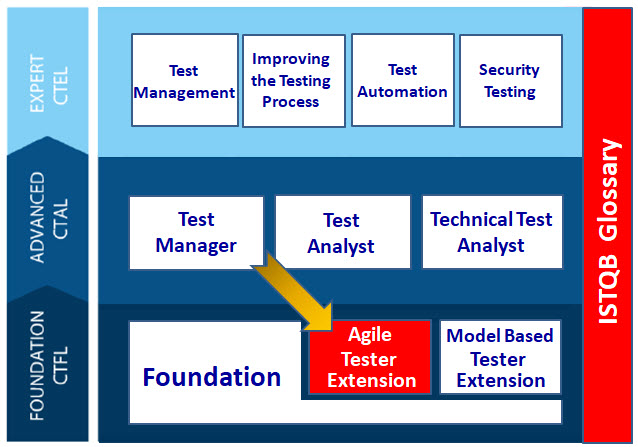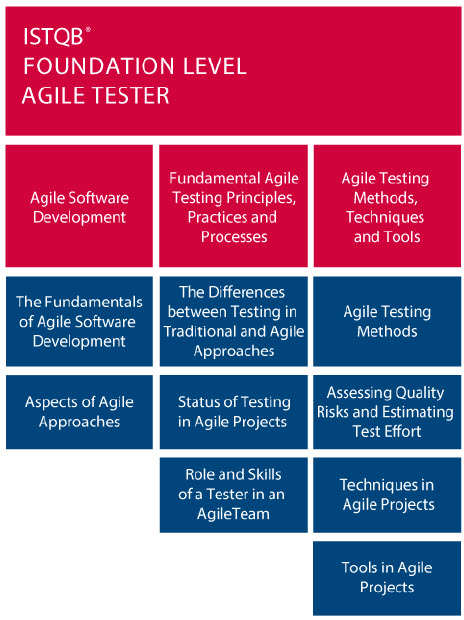Quick Start to preparation for ISTQB Agile Tester Extension Exam
What are ISTQB “Extensions”?
There had been a great demand for enhancing competence in vertical testing. Hence ISTQB came out with a novel concept of “Extension”.
“Extensions” are certification modules focused on topics, like:
1) Domain-specific testing practices;
2) Specific Testing Techniques;
3) Specific Testing Methods;
To pursue any “Extension”, ISTQB Foundation Level Certification (CTFL) is an essential pre-requisite.
ISTQB came out with its first “Extension” by the name “Agile Tester” in June 2014.
A) Check out if “ISTQB Agile Tester Extension” exam is meant for you?
Are you already having ISTQB Foundation certificate (CTFL)? &
Are you a tester having experience with traditional SDLCs? &
Are you an entry-level tester having interest in agile testing? &
Are you a developer with experience of testing work in agile projects? &
Are you interested in improving your agile testing skills? &
Are you passionate to be a professional in
testing with roles like – test analyst, test engineer, test consultant, test manager, user acceptance tester etc.? &
Most Important – Don’t want to pursue a Formal Expensive Training Course?
If Yes !!! Come on & read further.
B) Important Facts you must know
Where “Agile Tester” certification is positioned in ISTQB certifications map.

C) About the exam and syllabus:
1) In general, the entire syllabus is divided into three parts;
Part-1: Agile Software Development
Part-2: Fundamental Agile Testing Principles, Practices, and Processes
Part-3: Agile Testing Methods, Techniques, and Tools
Subdivisions under each part of the syllabus are as shown;

Learning Objectives of Chapter-1:
The fundamentals of agile software development;
# Recall the basic concept of agile based on the Agile Manifesto
# Understand the advantages of the whole-team approach
# Understand the benefits of early and frequent feedback
Aspects of agile approaches;
# Recall agile software development approaches
# Write user stories in collaboration with development, business representative and product owner
# Understand how retrospectives can be used as a mechanism for process improvement in agile projects
# Understand the use and purpose of continuous integration
# Know the differences between iteration and release planning, and how a tester adds value to each of activity
Learning Objectives of Chapter-2:
Differences between testing in traditional and agile approaches
# Describe the differences between testing activities in agile projects and non-agile projects
# Describe how coding and testing activities are integrated in agile
# Describe the role of independent testing in agile projects
Status of testing in agile projects
# Describe the basic set of work products used to communicate the status of testing in an agile project, including test progress and product quality
# Describe the process of evolving tests across multiple iterations and explain why test automation is important to manage regression risk in agile projects
Role and skills of a tester in an agile team
# Understand the skills of a tester in an agile team
# Understand the role of a tester within an agile team
Learning Objectives of Chapter-3:
Agile testing methods
# Recall the concepts of test-driven development, acceptance test driven development and behavior driven development
# Recall the concepts of the test pyramid
# Summarize the testing quadrants and their relationships with testing levels and testing types
# For a given agile project, practice the role of a tester in Scrum team
Assessing quality risks and estimating test effort
# Assess product quality risks within an agile project
# Estimate testing effort based on iteration content and product quality risks
Techniques in agile projects
# Interpret relevant information to support testing activities
# Explain to business stakeholders how to define testable acceptance criteria
# Given a user story, write acceptance test-driven development test cases
# Write test cases, for both functional and non-functional aspects, using black box test design techniques based on given user stories
# Execute exploratory testing to support the testing of an agile project
Tools in agile projects
# Recall different tools available to testers according to their purpose and to the activities in agile projects
2) Examinable Learning Objectives (K-Levels):
Since you have already cleared the ISTQB Foundation Level exam, hence must be familiar with the levels of understanding or cognitive levels, represented by the term (K1), (K2), (K3)…. etc. In the Agile tester extension syllabus, the topics covered are examinable up to maximum level (K3).
1) Level K1 refers to the ability to recall, so that you should be able to remember but not necessarily use or explain.
2) Level K2 refers to the ability to explain a topic or to classify information or make comparisons.
3) Level K3 refers to the ability to apply a topic in a practical scenario.
Detailed understanding of K-Levels
3) Structure of Exam Question Paper:
# Type of Questions – multiple choice type;
# Number of questions – 40
# Minimum Passing Score – 65%
# Duration of the exam – 60 minutes.
D) Possible professional contributions by Certified Agile Testers:
Agile tester extension certification is an additional feather in the cap of the CTFL certified professional. Certified Agile tester is expected to acquire additional skills due to which they should be able to;
1) Collaborate with an agile team, being familiar with agile principles and practices within an Agile environment.
2) Adapt existing testing experience, knowledge, and best practices.
3) Support the agile team in planning test related activities.
4) Apply relevant testing methods and techniques.
5) Assist in test automation in Agile projects.
6) Help business stakeholders define understandable and testable user stories and acceptance criteria.
7) Effectively work and share information with other team members.
Due to the specialized skills that come by virtue of certification, the Agile Tester should be able to work effectively in an agile environment as a part of an Agile team.
Ref.: ISTQB_Agile_Tester_Nutshell_2014_May.pdf from istqb.org
ISTQB Agile Tester Extension Exam Crash Course

An expert on R&D, Online Training and Publishing. He is M.Tech. (Honours) and is a part of the STG team since inception.

Very nice post here thanks for it .I always like and such a super contents of these post.Excellent and very cool idea and great content of different kinds of the valuable information’s.